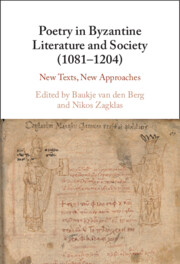Book contents
- Frontmatter
- Dedication
- Contents
- List of Figures
- List of Tables
- List of Contributors
- Introduction: Poetry in Byzantine Literature and Society (1081–1204)
- Part I Poetry and Twelfth-Century Literary Culture
- 1 ‘The Force of Discourses’: Literary Production in the Komnenian Era
- 2 Poetry and Theatre in Twelfth-Century Constantinople
- 3 Rethinking the Mixed Style in Twelfth-Century Poetry
- 4 ‘Wishing to Imitate the Poet’: Prose and the Study of Ancient Poetry in the Twelfth Century
- Part II Poetry and the School
- Part III Poetry, Patronage and Power
- Part IV New Texts, New Interpretations
- Index
1 - ‘The Force of Discourses’: Literary Production in the Komnenian Era
from Part I - Poetry and Twelfth-Century Literary Culture
Published online by Cambridge University Press: 17 October 2024
- Frontmatter
- Dedication
- Contents
- List of Figures
- List of Tables
- List of Contributors
- Introduction: Poetry in Byzantine Literature and Society (1081–1204)
- Part I Poetry and Twelfth-Century Literary Culture
- 1 ‘The Force of Discourses’: Literary Production in the Komnenian Era
- 2 Poetry and Theatre in Twelfth-Century Constantinople
- 3 Rethinking the Mixed Style in Twelfth-Century Poetry
- 4 ‘Wishing to Imitate the Poet’: Prose and the Study of Ancient Poetry in the Twelfth Century
- Part II Poetry and the School
- Part III Poetry, Patronage and Power
- Part IV New Texts, New Interpretations
- Index
Summary
The chapter looks at a substantial number of texts outside the boundaries usually placed in Byzantine Studies through conventional taxonomic categories such as genre or antithetic pairs like learned versus vernacular language. Four larger themes are used to explore this varied textual production and offer a proposal for understanding its basic socio-cultural and aesthetic functions for its immediate recipients and later readers. The four themes discussed are education and literature, patronage and literary production, rhetoric and genre in prose and poetry, narrative art from the enormous to the small. Despite the strong presence of ‘Hellenic’ subjects, Komnenian literature owes more to its own dynamism (deriving from a reformed teacherly practice in the schools) than to the imitation of ancient models. At the same time, the role of the patrons in promoting literary production shapes much of both learned and vernacular literary experimentation, while religious literature generously defined is strongly involved in an ongoing experimentation with form and content. Finally, the chapter asks whether any form of change can be traced within the literary production of the Komnenian era.
Keywords
- Type
- Chapter
- Information
- Poetry in Byzantine Literature and Society (1081-1204)New Texts, New Approaches, pp. 31 - 69Publisher: Cambridge University PressPrint publication year: 2024

